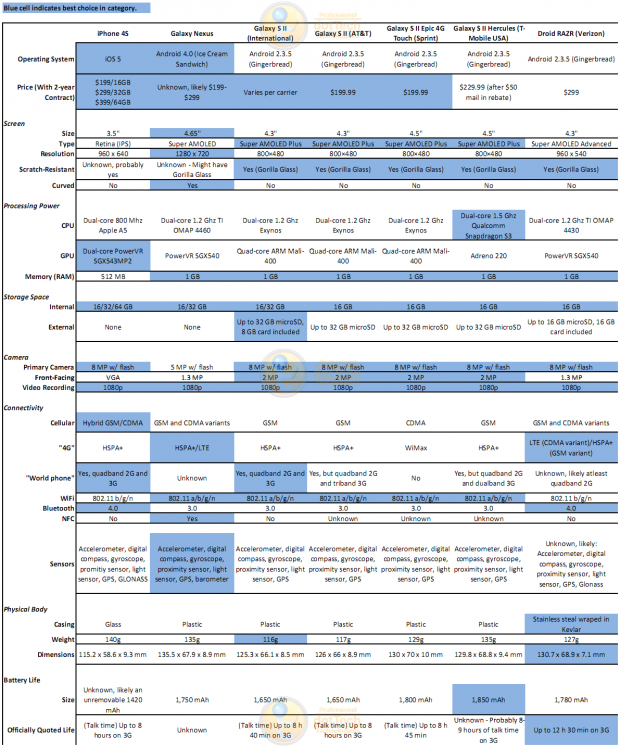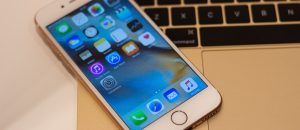Originally written on October 19, 2011. Updated on October 21, 2011 to clarify Galaxy Nexus has a Super AMOLED display, not Super AMOLED Plus.
Samsung Galaxy S II hit USA shores a few weeks ago (the rest of the world got it earlier this year back in May). iPhone 4S was released last week. Samsung Galaxy Nexus and Motorola Droid RAZR were announced in the past 24-hours. With so many juicy handsets going around, it is hard to decide which one to get. (Although, admittedly, your choices will be limited by which carrier you are with.) That is why dotTech has put together an analysis comparing the best smartphones available on the market right now: iPhone 4S vs Galaxy Nexus vs Galaxy S II (including carrier variants) vs Droid RAZR. Check out the detailed chart below followed by a discussion to learn more. Hopefully you will have a better idea on what phone to grab by the time you are done reading this article.
iPhone 4S vs Galaxy Nexus vs Galaxy S II (including carrier variants) vs Droid RAZR
Features/Specs Comparison Chart
(Click on the chart to view it in full size.)
Note: At this time, both the Galaxy Nexus and Droid RAZR have only been announced — not released.
Droid RAZR is going to be a Verizon exclusive in the USA, while Rogers in Canada is also confirmed to get it. No word on other carrier support around the world. Verizon is rumored to release Droid RAZR on November 10, 2011.
There has been no information on which carriers will be getting Galaxy Nexus. Only Japans’ NTT Docomo has been officially confirmed; and Verizon is rumored to get it. No word on other carrier availability. Verizon is rumored to release Galaxy Nexus on November 10, 2011
Discussion
If you feel overwhelmed by the chart shown above, don’t worry — it is overwhelming. As you may have noticed, many featured displayed in the chart are similar across the handsets. In other words, all seven handsets are probably more similar than they are different (give or take). So let’s break this analysis down into a few key points that are likely to be the deciding factors in which handset you go with (assuming, of course, you are not limited by carrier choice).
Operating System
The most obvious distinguishing factor here is that the iPhone 4S runs on iOS (v5) whereas the other six run on Android. If you are a diehard iOS fan, then there really is no need to look further since only one handset runs on iOS.
Among the Android handsets, Galaxy Nexus runs (or will run, when it is released) Android 4.0, aka Ice Cream Sandwich. Ice Cream Sandwich is the latest version of Android, with the latest features, improvements, performance tweaks (e.g. optimization for dual-core processors), etc. Running Android 4.0 provides Galaxy Nexus a clear advantage over the other five handsets because, as many people can attest to, Android manufacturers are very slow in updating handsets to the latest version of Android. In other words, the Galaxy S II/carrier variants and Droid RAZR will most likely get Ice Cream Sandwich — we just don’t know when they will get it. It could be a month later, three months later, six months later… there is no way of knowing.
Now does that mean the Galaxy S II/carrier variants and Droid RAZR are outdated because they don’t run the latest version of Android? No. Gingerbread is still an excellent version of Android (and, technically, it was the “latest” version until 24-hours ago when Ice Cream Sandwich was announced) and the user experience on Gingerbread handsets is still top-notch; plus you will still be able to use 99% of apps (the other 1% being Ice Cream Sandwich only apps that will popup sooner or later). However, it does mean if you are a stickler for the latest version of Android (*cough* Ashraf *cough*) then Galaxy Nexus should be your handset of choice. Not only will Galaxy Nexus run the latest version of Android when it is released, but since it is a Nexus phone (i.e. Google manages the software themselves, there is little to no manufacturer/carrier interference) the Galaxy Nexus will get very fast updates when new versions of Android are released in the future.
Screen
Before I discuss anything about screens, let me say this: All seven handsets have excellent displays. If I were to split hairs, I would say Super AMOLED Plus is the best display type. However, from the Retina display in the iPhone 4S, to the Super AMOLED in the Galaxy Nexus, the Super AMOLED Plus in the Galaxy phones, and Super AMOLED Advanced in the RAZR, your visual senses will feel like they are in heaven when you lay eyes upon any of these gorgeous displays. Thus, since we can only split hairs on display type, the main difference between the screens comes in the realm of size and resolution.
Preferred display size varies from person to person; one person may prefer a 3.5 inch screen while another may prefer a 4.3 inch screen. However, be that as it may, a larger screen is typically considered to be better than a smaller screen because activities like playing games, watching videos, and surfing the web are more enjoyable on a larger screen. In that regard, the iPhone 4S (3.5″) is the biggest loser with the Galaxy Nexus (4.65″) coming out on top; the other handsets fall in between with 4.3-4.5″.
Of course, there is a point when diminishing returns hit and a screen becomes too big; when this point is reached will depend on your personal tastes. (For me, personally, I feel phones are too large if the screen is bigger than 4.3 inches. However, I would never rule out a phone with a screen larger than 4.3 inches without first holding the phone in my hand to see how it feels. If it feels fine – usable with one hand without any strain – I would definitely consider it as a possibility.) So while the Galaxy Nexus may have the largest screen, some people may prefer to go with a different handset because of the smaller – yet still vivid – display. For what it is worth, the Galaxy Nexus display is curved, so it feels smaller in hand than a non-curved display of same size.
The other aspect where the displays vary is resolution. Similar to the idea of bigger = better in display size, when it comes to screen resolution, bigger = better. The logic behind this is a) the larger resolution display you have, the more content you can fit on the screen at a time without scrolling, such as when you are surfing the web and b) the larger resolution you have the larger pixel density you have which leads to crisper images. (Pixel density also depends on screen size, though. When I say larger resolution leads to larger pixel density I am speaking relatively — talking about varying resolutions on displays of the same size.) Since, as I mentioned previously, all of these handsets have terrific displays, the latter point about larger pixel density and crisper images isn’t too important: The Galaxy S II handsets may have the lowest pixel density out of all seven handsets, but the Super AMOLED Plus display is still extremely vibrant and vivid — nothing to complain about. The former point also is not too big of an issue for most people; most people probably won’t ever notice a difference in screen resolution unless they compare devices side-by-side. However, if you are one of those people that must absolutely have the largest resolution, Galaxy Nexus is the phone to go. It should be noted, though, because of iPhone 4S’s smaller screen size, it has the largest pixel density of all the handsets.
Processing Power
As shown in the chart above, all seven handsets have dual-core processors. If measured in just megahertz, T-Mobile’s Galaxy S II has the “strongest” CPU. However, in terms of real-world performance, the processors on each phone provide/will provide excellent performance with little to no lag. If you are thinking “T-Mobile’s Galaxy S II is so much better than the iPhone 4S because it has a 1.5 Ghz dual-core processor and the iPhone 4S only has a 800 Mhz dual-core processor” then you are too fixated on the spec cheat. True, technically, T-Mobile’s Galaxy S II’s processor is clocked almost twice that of iPhone 4S’; but that doesn’t mean the iPhone 4S will lag while T-Mobile’s Galaxy S II will soar. Both devices provide excellent performance. In fact, if anything, iPhone 4S’s lower clocked processor helps conserve battery life more than T-Mobile’s Galaxy S II’s higher clocked processor.
In regards to GPU, Apple’s iPhone 4S pulls way ahead of the crowd. The dual-core PowerVR SGX543MP2 is the most powerful GPU on the mobile market at this time and in benchmarks it wipes the floor with the competition. Yes, it even beats the quad-core Mali-400 in the Galaxy S II. (This is a perfect example of how more cores doesn’t necessarily mean better or more powerful.) However, notice I said benchmarks. In real-world performance, the GPU on the Galaxy S II/variants will be able to handle everything you throw at it. So, unless you are a geek that just wants the best GPU, the difference between SGX543MP2 and Mali-400 shouldn’t be a deciding factor in what phone you get. What is worth noticing, however, is the fact that the Galaxy Nexus and Droid RAZR use a PowerVR SGX540 chip.
The PowerVR SGX540 is “last year’s model”; it is the chip that was used in the Samsung Galaxy models of last year. That is not to say the PowerVR SGX540 is “weak”, per se. As I mentioned in a previous article, some people would argue the full power of the PowerVR SGX540 has not been utilized yet even though the chip is “old”: The Galaxy Nexus and Droid RAZR will still be able to view videos (in HD, for the Galaxy Nexus), play games, etc. just fine. However, literally using last year’s GPU is highly disappointing in these otherwise great handsets.
Update: It is worth mentioning that the Galaxy Nexus runs at a much higher resolution that previous phones (1280 x 720). There are some valid concerns that the SGX540 may not be powerful enough to render some games at 1280 x 720 resolution. Only time will tell what happens.
Connectivity
Aside from screen size, probably one of the biggest factors in determining what phone you grab is connectivity. In other words, do you want a phone with 4G or will you be satisfied with 3G? Would you like to be able to roam globally with your device or not?
For roaming globally, iPhone 4S is the winner. iPhone 4S has both GSM and CDMA radios built-in and supports quadband 2G and 3G. So, technically, you should be able to use an iPhone 4S on literally any cellular network in the world and get 2G on all of them and 3G on most of them. (Assuming the iPhone 4S is unlocked, of course.) Now that doesn’t mean the other six devices can’t roam globally. With the exception of Galaxy S II Epic 4G Touch (Sprint’s Galaxy S II), all the other devices can roam globally. However, some devices may not get 3G (this will depend on the 3G frequency used the international carriers). They will all 2G on GSM networks worldwide, but some may or may not get 3G. If you are a global roamer, this may be a make or break point for you.
For 4G connectivity, Galaxy Nexus and Droid RAZR are the big winners with LTE; and since Verizon’s blazing fast LTE network reaches a good part of the USA already and is continually expanding, having LTE on a handset – if you are a Verizon customer – is a huge pro in favor of the Galaxy Nexus and Droid RAZR. Galaxy S II Epic 4G Touch comes in second with WiMax support, assuming you live in a city that has Sprint’s WiMax. The other handsets round out the game with fake 4G, otherwise known as HSPA+. (T-Mobile’s Galaxy S II has the fastest HSPA+ with theoretical speeds of 42 Mbps.) It should be noted that the iPhone 4S on Sprint and Verizon doesn’t get 4G at all. Since HSPA+ is only supported on GSM networks, iPhone 4S can get fake 4G… but only on the GSM networks that support HSPA+, e.g. AT&T.
Battery Life
Battery life is an important issue when discussing smartphones because you want to be able to use your phone without having to be stuck to an outlet all day. Although other phones may have larger batteries – with T-Mobile’s Galaxy S II having the largest one at 1,850 mAh – historically the iPhone has been the best smartphone in terms of battery life; and Android handsets have been poor battery performers. Things are changing, however.
Many critics that have used the Galaxy S II have claimed it has great battery life (a huge improvement over Galaxy S, the original); and Motorola has typically always done well in power conservation, even when other Android manufacturers were failing. So while in the past iPhone was the clear winner when it came to battery life, now it is not so much. Does that mean all the above-mentioned Android handsets will provide as good battery life as iPhone 4S? I don’t know — no one has tested it to find out for sure. If I were to guess, I would say probably not. My guess is iPhone 4S, even though it has a smaller battery, will still have better battery life than the other six handsets. (Battery savings is an advantage for having a smaller screen and lower clocked processor.) However, the other six handsets also provide/will provide great battery life. So if you absolutely need a phone with the best battery life, you should go with the iPhone 4S. However, if you just require a phone with good/great battery life, then all seven devices are up for grabs.
Update: There are reports iPhone 4S has “terrible” battery life. Just an FYI.
Conclusion
It may sound odd to some people, but deciding on a smartphone is a big decision, especially if you won’t be able to switch to a new handset for two years. Hopefully this article has helped you make a better informed decision. If anything, you should take away from this article that no device is “the best” or “perfect”; each device has its pros and cons and which device you should get will depend on your needs and preferences.
If you own or plan on owning any of the devices mentioned in this article, we would love to hear your feedback in the comments below. Also, feel free to discuss anything about iPhone, Android, or mobile phones in general.

 Email article
Email article




